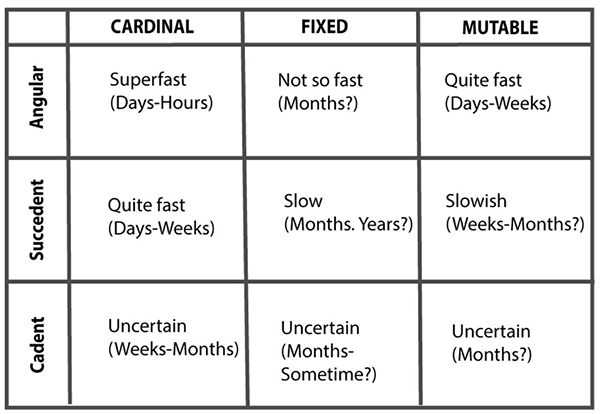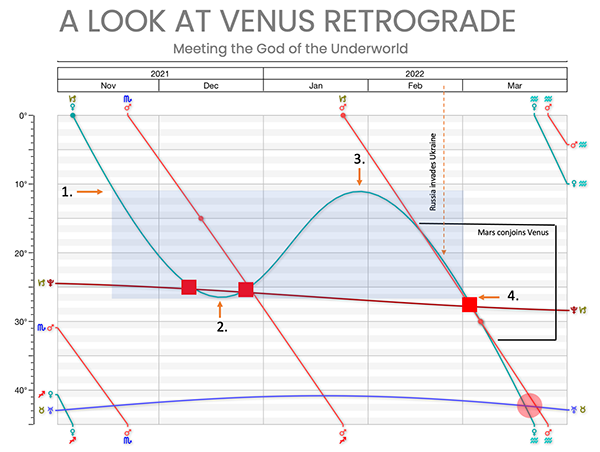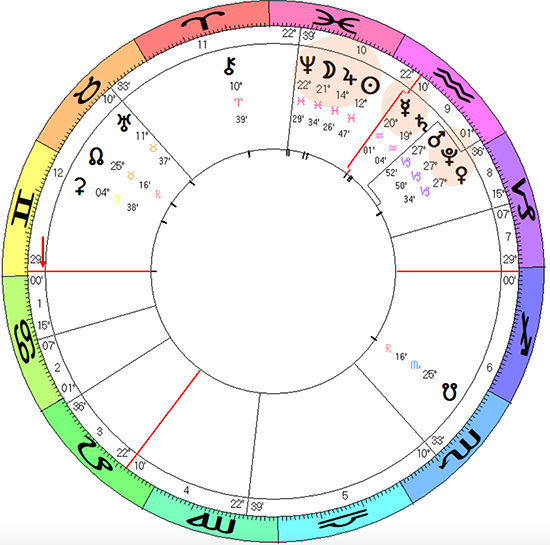Part Three: Timing and Retrogrades
Timing is tricky. Often you need to look at a combination of factors to make an educated guess at timing. It helps to discuss realistic options with the client, which can remove some of the guesswork. For example, if a person asks when they can leave their job, but is contractually obliged to stay for a specified period of time, then it helps to know. When looking at timing over long periods, transits and progressions will pinpoint periods with a window of a few months, and when they are used in combination with the horary chart, it helps determined what unit of time you are looking at – weeks, months or years.
The Angles
One really good indication of whether a change is imminent is when the Ascendant/Descendant or MC/IC axis changes signs. At zero or one degrees, a change should already have taken place, but at 29 degrees, then a change is imminent within one unit of time. So, if a client was in a job but considering change, then 29 degrees would indicate that change would happen in a year, and 29½ would show it happening within 6 months. If the client was desperate to change right now, then the unit to use might be a month.
The Sun
The fact that the Sun moves one degree every day, makes this a reliable timer, if the Sun is a significator. In this case it is just a question of equating the number of degrees the Sun will travel before it makes the relevant aspect to another significator. Generally the Sun is good as an indicator of months, but it can also represent days, for an imminently expected event, or years, for a more distant expectation, like whether the client may have a child.
Planetary Speed
Traditional astrologers like William Lilly also took into account the relative speed of planets. One view of this is that Mercury is the fastest mover, whilst Saturn is the slowest, and as significators, speed should be timed accordingly… if Saturn represents the querent, then things take time. It will always be the fastest significator that takes the initiative, so Saturn can generally play a waiting game. Similarly, if the two significators are Mercury and Jupiter, then Mercury is the one that must approach Jupiter. There can be unusual exceptions to this. For example in February 2022, Mars moved faster than Venus for quite some time, so was therefore the initiator of contact.
The Moon varies in speed according to how close it is to the Earth. When at perigee it moves almost 15 degrees a day, whilst at apogee it moves a little less than 11 degrees. According to Lilly, this was an important factor in determining whether something would happen fast or slow.
Because of retrograde movement, all the other planets can be moving slow or fast – or backwards. Mercury can move backwards at a maximum speed of 35 minutes of arc a day, and forwards at a maximum speed of up to two degrees. At its fastest, Mercury as significator shows someone rushing ahead to achieve something. When the significator for the client is stationary, the person is often feeling extremely frustrated – getting nowhere – although really they are at a turning point.
Using the Ephemeris
Timing can be a lot easier when Jupiter or Saturn are involved, especially if you are looking for them to aspect each other as significators. In this case, it is normally just a question of following the ephemeris. The next aspect Jupiter makes to Saturn, whether direct or retrograde, should show the date when the desired result is achieved.
When pinpointing a date, it is sometimes possible to look ahead in the ephemeris to see when two significators make the right aspect. For example, an engagement made at a conjunction of Venus and Mars, may show a coming wedding at the sextile, trine or coming opposition.
Classical Timing
Whether results would actualize, and when, was traditionally indicated by whether significators where in Cardinal, Fixed or Mutable signs, combined with whether they were in Angular, Succedent or Cadent houses.

The important things about this timing table is not to take it too literally. A significator in a Fixed sign and Cadent house can still indicate something happening within days or weeks, if commonsense indicates this to be a reasonable guess. (For example if a client represented by Mercury in Taurus in the 9th, which is about to sextile Jupiter, asks whether to start a course or journey that is due to take place soon.) On the other hand, if a significator is in a Cardinal sign and Angular house, you can be reasonably certain that things are going to happen fast.
Orbs and Timing
The basic rule of timing is that the closer the orb between two significators, the faster the result. So, if the orb between two significators is applying and is just one degree, then the result is imminent. As the orb increases, so does the time interval, and as the significators move out of aspect, then the expected result becomes more subject to chaos theory – in other words, unknown factors can interfere with the result.
Nevertheless, just as long as a significator planet ultimately makes a Ptolemaic aspect within the same sign, there is still a good chance of perfection, even when the orb is very large. When this is the case, the planet may often have to traverse a series of aspects before meeting the quesited, and each of these planets will have a story to tell. However, if one of the two significators moves out of their signs before perfection occurs, it is not likely that there will be a result, unless that significator moves retrograde and re-forms the aspect.
Traditionally, if one significator aspects Saturn before aspecting the other significator, which is known as prohibition, then the process is deemed to be stopped dead, but Saturn could just show a difficult obstacle in the path, rather than completely preventing perfection. For example, if Mars, a man, wanted to ask Venus, a woman, out on a date, but before Venus trined Mars, she squared Saturn, the father may temporarily succeed in preventing the date, but when the parent lets his guard down, she probably would not be able to resist the chemistry anyway.
Retrograde Mercury and Venus
These two planets are in a class of their own, when considering timing. When Mercury is going at speed, then things happen fast, but as it slows down to go retrograde, as it does at three times a year, then frustrations build up. Things are going to take longer than expected. If Mercury, the quesitor, goes retrograde at 15 degrees, and the quesited is represented by a planet at 16 degrees, then basically perfection will not occur, at least for the time being. This is because Mercury has unfinished business.
The degrees between Mercury stationary retrograde and stationary direct – normally about 10-13 degrees – are known as the shadow or loop. As soon as Mercury enters the degree where it later will go stationary direct, it enters the shadow. This inaugurates a self-contained period – a cycle of time that the client must undergo before coming out the other side. Whatever issues the client gets involved with at this time will go through three phases: initial expectation, setback, then resolution.
What is crucial are the aspects Mercury, or for that matter Venus, make during the course of the shadow period. Often there will be three aspects to the same planet, direct, retrograde and direct again, and this is extremely important, representing opportunities lost and found again, or information that misleads, is investigated and then is ready to be acted on.
In December 2021 Venus went retrograde at 26.29 Capricorn (2), which meant that it conjoined Pluto for a two-week period around Christmas. Venus turned direct at 11.04 Capricorn on January 29th (3), exactly trine Uranus in Taurus. Venus entered the shadow on November 16th 2021 (1), and left on April 28th (4), and this whole period was therefore dominated by Pluto on the one hand, and Uranus on the other.

Anyone represented by Venus at this time would have been in dire straits. Whenever Venus meets Pluto it is like a replay of the old myth, where Persephone gets abducted by Hades. Venus retrograde here shows a desperate attempt to escape, and the trine to Uranus represents an opportunity for liberation. What is extraordinary about this period, is that as Venus moves direct again, and is slow in motion, Mars catches up with Venus and throughout February Venus is held in the vice-like grip of Mars exalted in Capricorn, first with Mars overtaking Venus, and then with Venus overtaking Mars.
The Mars-Venus conjunction starts in trine to Uranus, so one story could be that Mars is the valiant knight, shielding Venus on her third passage past Pluto, when all three planets are at 27 Capricorn in early March. Of course this can be interpreted in many different ways. This was the time when we were all asking will there be war (Mars) or will there be peace (Venus) and events showed, with the invasion of Ukraine, that destruction could not be avoided.
Nakba – the catastrophe
This consultation chart from March 3rd 2022 shows a client, working in Britain and contemplating returning to Israel. She has decided not to continue with her studies abroad – that’s Mercury hitting Saturn in the 9th. Her mother was Arab-Palestinian, and her father an Israeli Jew, and they argued violently and ultimately divorced. This client stated that all relationships were completely transactional. She was adamant that love was illusory. She actually said that the thought of a man-woman relationship was “grotesque”. That was clearly a reflection of Mars, Venus and Pluto conjoining in the 8th house, obviously reflecting trauma. I could not help thinking that it also showed the trauma of the Palestinian population who lost everything at the Israeli victory at the 1948 War of Independence – the Nakba. The client’s refusal to even contemplate love seemed to reflect the greater hatred that is a feature of the Israel-Palestine conflict.

Palestinian client. March 3rd 2022 11.00 Berlin (AS 29 GE)
Horary charts, and particularly the consultation chart, deliver extraordinary insight into both the current situation and a person’s character, reflecting both the big questions being asked today, and the history and heritage of the querent. Being in tune with the planetary patterns as they unfold, brings attunement on multiple levels, enhancing awareness in relationships, on a consciousness level, and collectively, regarding world events. Horary astrology is no more nor less than being aware of what is happening here and now – it’s a spiritual practice.
Adrian Ross Duncan
May 16th, 2022.
